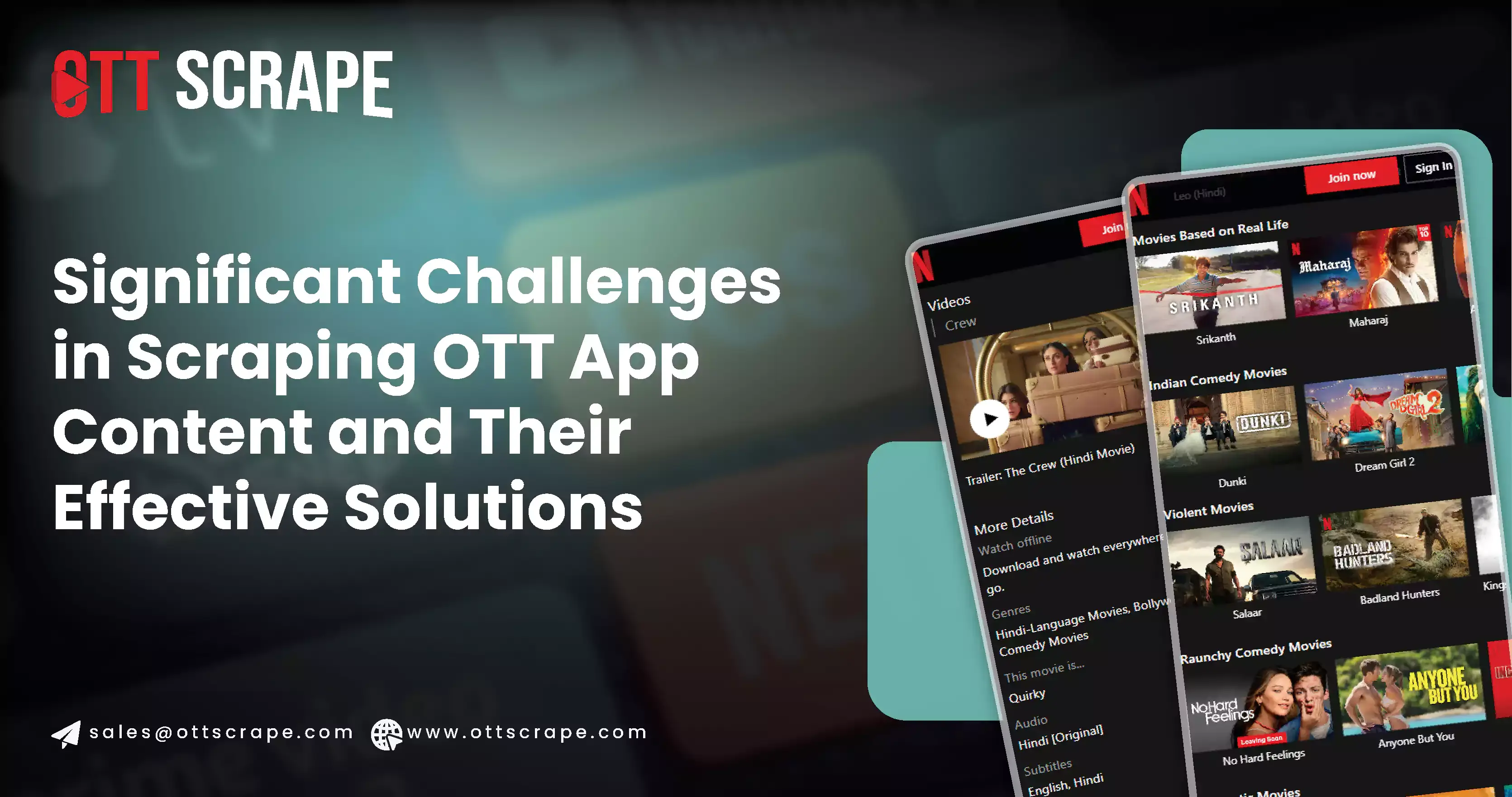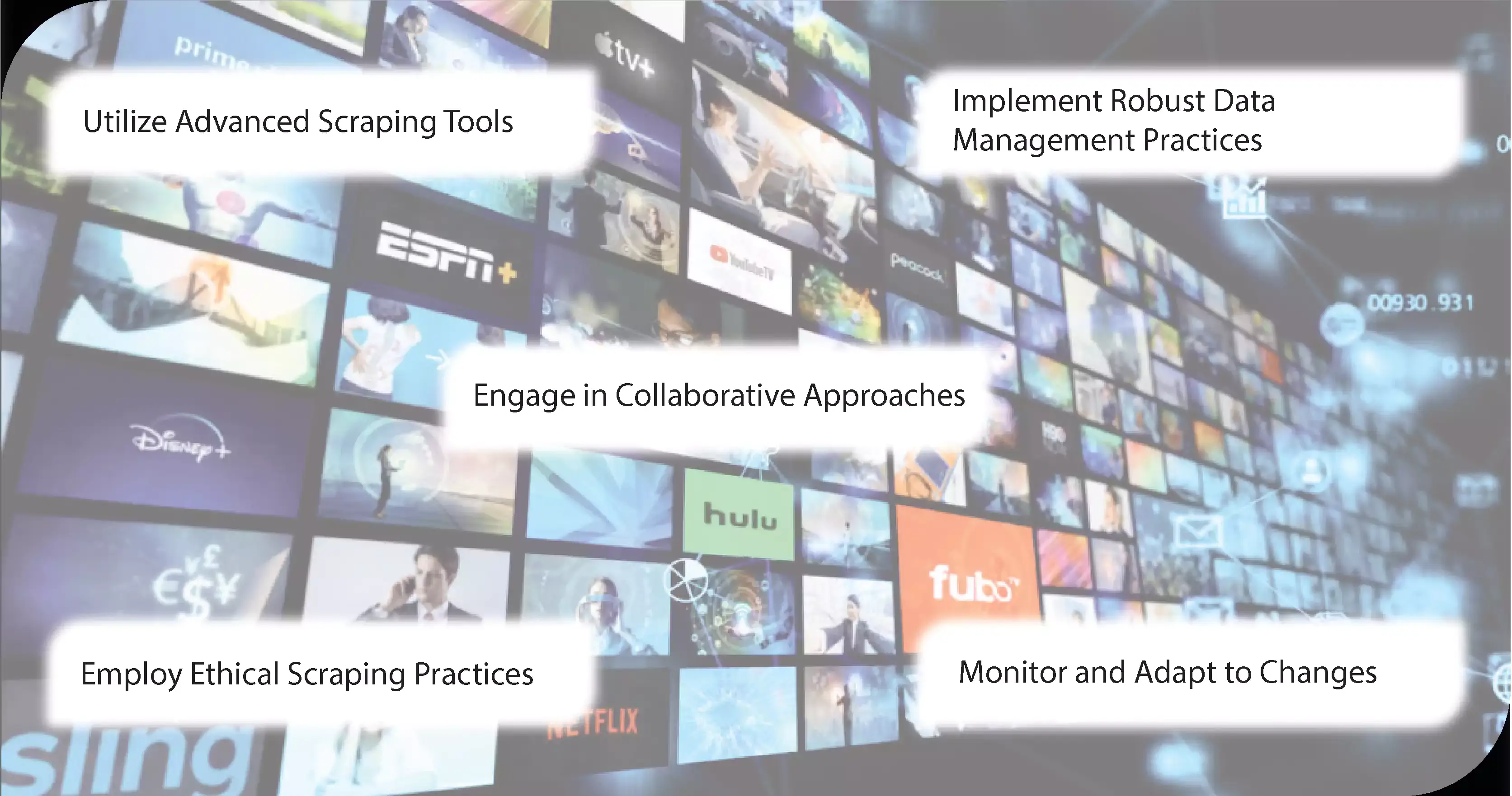
With the explosion of over-the-top (OTT) platforms, such as Netflix , Hulu, and Amazon Prime Video, the demand for scraping content from these services has increased significantly. Data scraping from OTT apps provides valuable insights into content offerings, user preferences, and competitive analysis. However, scraping content from these platforms presents several challenges due to their complex structures and security measures. This article explores the primary challenges faced when scraping OTT app content and offers practical solutions to address these issues.
Challenges in Scraping Content from OTT Apps

Listed below are the major challenges that might occur while scraping OTT data and the solutions to overcome the same.
1. Dynamic Content and JavaScript Rendering
OTT platforms often use JavaScript to load content dynamically. This means the data you see on the page might not be present in the initial HTML but loaded through asynchronous requests. Scraping static HTML alone will not be sufficient to capture this dynamic content.
Solution: To handle dynamic content, use tools that can render JavaScript, such as Selenium or Puppeteer. These tools simulate a natural browser environment and can execute JavaScript to load the content entirely. Additionally, analyzing network requests made by the app can help identify API endpoints from which data can be directly fetched.
2. Anti-Scraping Measures
OTT platforms employ various anti-scraping techniques to protect their content and data. These measures include CAPTCHAs, rate limiting, IP blocking, and detecting automated browsing patterns. These protections are designed to prevent unauthorized OTT app scraping and ensure the integrity of their services.
Solution: Overcoming anti-scraping measures involves employing several strategies:
•CAPTCHA Solvers: Use services or tools designed to solve CAPTCHAs automatically. Manual solving might be required for more complex CAPTCHAs.
•IP Rotation: Utilize proxy networks or rotating IP services to distribute requests and avoid detection.
•Request Throttling: Implement delays between requests to mimic human browsing behavior and reduce the risk of being blocked.
3. Authentication and Session Management
Many OTT platforms require user authentication to access content. This typically involves logging in with credentials and managing sessions through cookies or tokens. Scraping streaming content with proper authentication can be easy.
Solution: To manage authentication, use automated tools that handle login processes. Securely store session cookies or tokens and include them in subsequent requests. Tools like Selenium can automate login processes and handle session management effectively.
4. Complex Website Structures
OTT platforms often have complex website architectures with multiple layers of content and navigation. Scraping content from these sites requires understanding and navigating through these structures.
Solution: Map out the website's structure by analyzing the HTML and JavaScript to identify critical elements and their relationships. Use web scraping frameworks like Scrapy to handle complex site structures by defining specific rules and extraction logic.
5. Legal and Ethical Concerns
Scraping content from OTT apps raises legal and ethical issues, including violations of terms of service, intellectual property rights, and privacy concerns. Unauthorized data extraction can lead to legal repercussions and damage the scraper's reputation.
Solution: Address legal and ethical concerns by:
•Reviewing Terms of Service: Always review and adhere to the OTT platform's terms of service. Ensure that scraping activities are compliant with these terms.
•Obtaining Permissions: When possible, seek explicit permission from the platform to scrape content.
•Respecting Data Privacy: Avoid scraping personal or sensitive data, and ensure that the data collected is used responsibly.
6. Data Quality and Consistency
Ensuring the accuracy and consistency of scraped data can be challenging due to variations in content formatting, updates, and website structure changes. Only accurate or consistent data can affect the reliability of the analysis.
Solution: To maintain data quality:
•Regular Monitoring: Continuously monitor and update scraping scripts to adapt to website structure changes.
•Data Validation: Implement validation checks to ensure the data collected is accurate and consistent. Cross-reference data with multiple sources when possible.
7. Performance and Scalability
Scraping large volumes of content from OTT platforms can be resource-intensive and impact performance. Efficiently managing performance and scalability using OTT data scraping services is crucial for large-scale scraping operations.
Solution: Enhance performance and scalability by:
•Parallel Processing: Use parallel processing techniques to distribute the scraping workload across multiple servers or instances.
•Efficient Data Storage: Store scraped data in scalable databases or warehouses to efficiently handle large datasets.
Practical Solutions for Effective OTT Scraping

1. Utilize Advanced Scraping Tools
Leverage advanced OTT data scraper and libraries that support dynamic content rendering and sophisticated scraping techniques. Selenium, Puppeteer, and Scrapy offer features for handling complex site structures, JavaScript rendering, and session management.
2. Implement Robust Data Management Practices
Adopt robust data management practices to ensure the quality and integrity of the scraped data. Use structured data storage solutions and implement data validation mechanisms to handle inconsistencies.
3. Employ Ethical Scraping Practices
Adhere to ethical scraping practices by respecting the terms of service, obtaining necessary permissions, and avoiding the collection of personal or sensitive information. Consider the impact of scraping on the website's performance and make efforts to minimize it.
4. Monitor and Adapt to Changes
Monitor the performance of your scraping scripts regularly and adapt to changes in the website's structure or anti-scraping measures. Stay informed about updates and developments in scraping technologies and legal regulations.
5. Engage in Collaborative Approaches
In some cases, collaborating with the OTT platform or using official APIs can provide a more reliable and compliant way to access content. Explore partnerships or agreements that align with both parties' interests.
Conclusion: Collecting content from OTT apps presents various challenges, from dealing with dynamic content and anti-scraping measures to managing authentication and legal concerns. By implementing advanced scraping tools, adhering to ethical practices, and employing robust data management strategies, businesses can effectively overcome these challenges and leverage OTT data for valuable insights. Continuous monitoring and adaptation to changes in website structures and anti-scraping technologies will further enhance the effectiveness and compliance of scraping operations. As the digital landscape evolves, staying informed about best practices and regulatory developments will be crucial for successful and responsible scraping of OTT app content.
Embrace the potential of OTT Scrape to unlock these insights and stay ahead in the competitive world of streaming!
